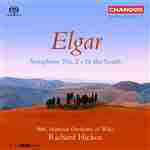
Symphony No. 2 / In the South
 $40.00
Out of Stock
$40.00
Out of Stock6+ weeks add to cart
ELGAR
Symphony No. 2 / In the South
BBC National Orchestra of Wales / Richard Hickox
[ Chandos SACD / Hybrid SACD ]
Release Date: Monday 1 August 2005
This item is currently out of stock. It may take 6 or more weeks to obtain from when you place your order as this is a specialist product.
'Critical comment on the recording of the Second Symphony:
Elgar's Second Symphony blossoms in the hands of Richard Hickox and the BBC National Orchestra of Wales.'
Classic FM Magazine 'Disc of the month'
Hybrid SACD - playable on all compact disc players
'Critical comment on the recording of the Second Symphony:
Elgar's Second Symphony blossoms in the hands of Richard Hickox and the BBC National Orchestra of Wales.'
Classic FM Magazine 'Disc of the month'
'Hickox steers a distinctive course through Elgar's elegiac Second..bringing out the glory of Elgar's orchestral imagination
(Gramophone)
Richard Hickox has an unparalleled record in his interpretations of British music. His series of Bridge's orchestral works has been described as one of the most important recording projects currently underway. In the face of fierce competition, his series of Vaughan Williams's symphonies has become one of the critics' top recommendations for the repertoire, his recording of Vaughan Williams's A London Symphony winning Gramophone's coveted 'Record of the Year'. With this impeccable pedigree in British music, he now turns his attention to the music of Sir Edward Elgar.
An Italian trip with his wife, Alice, in the spring of 1909, and in particular a visit to Venice, sparked off plans by Elgar for his Symphony No. 2 in E flat major, sketched during 1910 and completed in full score in two months of intensive work at the beginning of 1911. On the printed score Elgar bracketed two place names,Venice and Tintagel. In April 1910 he had spent a few days in Tintagel at the summer home of Alice Stuart-Wortley. His passionate friendship with her found expression in the symphony, as did the death of King Edward VII, to whose memory the symphony was dedicated. The score is also prefaced by the first two lines of a poem by Shelley: 'Rarely, rarely comest thou, / Spirit of Delight!' The 'Spirit of Delight' can be associated with the symphony's unifying motto theme, which in the first movement forms part of a first-subject group of furious energy. The slow movement dies away amidst echoes of the motto and a funeral-march offshoot. The contrast between this movement and the scherzo 'represented the contrast between the interior of St. Mark's at Venice and the sunlit and lively Piazza outside'. The sorrow expressed in the earlier movements is 'smoothed out and ennobled' in the finale, whose last climax collapses towards a serene ending, intermingling echoes of the movement's first theme and the 'Spirit of Delight' motto.
Elgar spent the last weeks of 1903 and the first of 1904 on holiday with his wife and daughter in Alassio, in the north-west Italian region of Liguria. There he completed In the South (Alassio), which he described as an attempt to capture 'the thoughts and sensations of one beautiful afternoon in the Vale of Andora'; on the manuscript he wrote quotations from Tennyson's The Daisy and Byron's Childe Harold's Pilgrimage, which indicate that Italian landscape and history were the twin sources of his inspiration. Despite its designation of 'concert overture' the work has the dimensions of one of Strauss's shorter symphonic poems, its form resembling that of Strauss's Don Juan.
Tracks:
Symphony No. 2
In the South

![Orchestral Works [6 CD set] cover](https://images.marbecks.co.nz/_thumbnails/10199/10199150.jpg)

